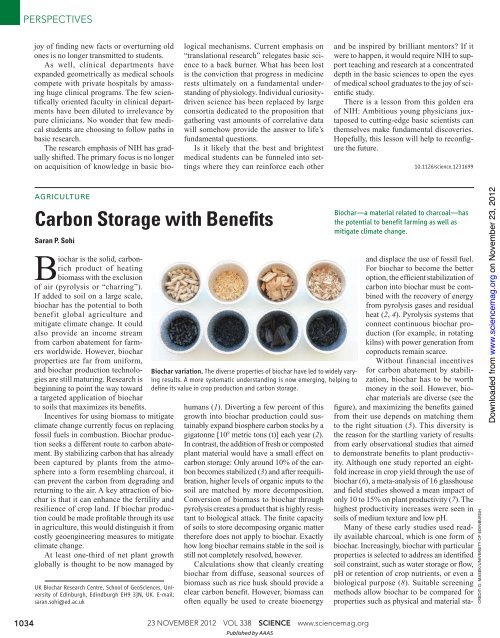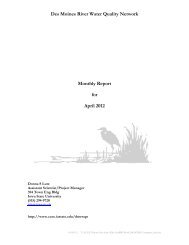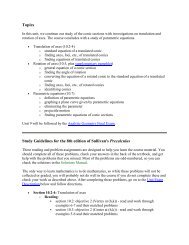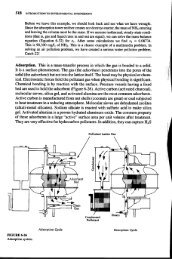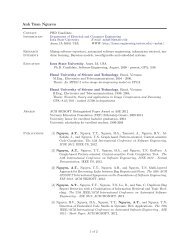DOI: 10.1126/science.1225987 , 1034 (2012); 338 Science Saran P ...
DOI: 10.1126/science.1225987 , 1034 (2012); 338 Science Saran P ...
DOI: 10.1126/science.1225987 , 1034 (2012); 338 Science Saran P ...
Create successful ePaper yourself
Turn your PDF publications into a flip-book with our unique Google optimized e-Paper software.
PERSPECTIVES<br />
<strong>1034</strong><br />
joy of fi nding new facts or overturning old<br />
ones is no longer transmitted to students.<br />
As well, clinical departments have<br />
expanded geometrically as medical schools<br />
compete with private hospitals by amassing<br />
huge clinical programs. The few scientifi<br />
cally oriented faculty in clinical departments<br />
have been diluted to irrelevance by<br />
pure clinicians. No wonder that few medical<br />
students are choosing to follow paths in<br />
basic research.<br />
The research emphasis of NIH has gradually<br />
shifted. The primary focus is no longer<br />
on acquisition of knowledge in basic bio-<br />
AGRICULTURE<br />
Carbon Storage with Benefi ts<br />
<strong>Saran</strong> P. Sohi<br />
Biochar is the solid, carbonrich<br />
product of heating<br />
biomass with the exclusion<br />
of air (pyrolysis or “charring”).<br />
If added to soil on a large scale,<br />
biochar has the potential to both<br />
benefit global agriculture and<br />
mitigate climate change. It could<br />
also provide an income stream<br />
from carbon abatement for farmers<br />
worldwide. However, biochar<br />
properties are far from uniform,<br />
and biochar production technologies<br />
are still maturing. Research is<br />
beginning to point the way toward<br />
a targeted application of biochar<br />
to soils that maximizes its benefi ts.<br />
Incentives for using biomass to mitigate<br />
climate change currently focus on replacing<br />
fossil fuels in combustion. Biochar production<br />
seeks a different route to carbon abatement.<br />
By stabilizing carbon that has already<br />
been captured by plants from the atmosphere<br />
into a form resembling charcoal, it<br />
can prevent the carbon from degrading and<br />
returning to the air. A key attraction of biochar<br />
is that it can enhance the fertility and<br />
resilience of crop land. If biochar production<br />
could be made profi table through its use<br />
in agriculture, this would distinguish it from<br />
costly geoengineering measures to mitigate<br />
climate change.<br />
At least one-third of net plant growth<br />
globally is thought to be now managed by<br />
UK Biochar Research Centre, School of Geo<strong>Science</strong>s, University<br />
of Edinburgh, Edindburgh EH9 3JN, UK. E-mail:<br />
saran.sohi@ed.ac.uk<br />
logical mechanisms. Current emphasis on<br />
“translational research” relegates basic science<br />
to a back burner. What has been lost<br />
is the conviction that progress in medicine<br />
rests ultimately on a fundamental understanding<br />
of physiology. Individual curiositydriven<br />
science has been replaced by large<br />
consortia dedicated to the proposition that<br />
gathering vast amounts of correlative data<br />
will somehow provide the answer to life’s<br />
fundamental questions.<br />
Is it likely that the best and brightest<br />
medical students can be funneled into settings<br />
where they can reinforce each other<br />
Biochar variation. The diverse properties of biochar have led to widely varying<br />
results. A more systematic understanding is now emerging, helping to<br />
defi ne its value in crop production and carbon storage.<br />
humans ( 1). Diverting a few percent of this<br />
growth into biochar production could sustainably<br />
expand biosphere carbon stocks by a<br />
gigatonne [10 9 metric tons (t)] each year ( 2).<br />
In contrast, the addition of fresh or composted<br />
plant material would have a small effect on<br />
carbon storage: Only around 10% of the carbon<br />
becomes stabilized ( 3) and after reequilibration,<br />
higher levels of organic inputs to the<br />
soil are matched by more decomposition.<br />
Conversion of biomass to biochar through<br />
pyrolysis creates a product that is highly resistant<br />
to biological attack. The fi nite capacity<br />
of soils to store decomposing organic matter<br />
therefore does not apply to biochar. Exactly<br />
how long biochar remains stable in the soil is<br />
still not completely resolved, however.<br />
Calculations show that cleanly creating<br />
biochar from diffuse, seasonal sources of<br />
biomass such as rice husk should provide a<br />
clear carbon benefi t. However, biomass can<br />
often equally be used to create bioenergy<br />
23 NOVEMBER <strong>2012</strong> VOL <strong>338</strong> SCIENCE www.sciencemag.org<br />
Published by AAAS<br />
and be inspired by brilliant mentors? If it<br />
were to happen, it would require NIH to support<br />
teaching and research at a concentrated<br />
depth in the basic sciences to open the eyes<br />
of medical school graduates to the joy of scientifi<br />
c study.<br />
There is a lesson from this golden era<br />
of NIH: Ambitious young physicians juxtaposed<br />
to cutting-edge basic scientists can<br />
themselves make fundamental discoveries.<br />
Hopefully, this lesson will help to reconfi gure<br />
the future.<br />
<strong>10.1126</strong>/science.1231699<br />
Biochar—a material related to charcoal—has<br />
the potential to benefi t farming as well as<br />
mitigate climate change.<br />
and displace the use of fossil fuel.<br />
For biochar to become the better<br />
option, the effi cient stabilization of<br />
carbon into biochar must be combined<br />
with the recovery of energy<br />
from pyrolysis gases and residual<br />
heat ( 2, 4). Pyrolysis systems that<br />
connect continuous biochar production<br />
(for example, in rotating<br />
kilns) with power generation from<br />
coproducts remain scarce.<br />
Without financial incentives<br />
for carbon abatement by stabilization,<br />
biochar has to be worth<br />
money in the soil. However, biochar<br />
materials are diverse (see the<br />
fi gure), and maximizing the benefi ts gained<br />
from their use depends on matching them<br />
to the right situation ( 5). This diversity is<br />
the reason for the startling variety of results<br />
from early observational studies that aimed<br />
to demonstrate benefi ts to plant productivity.<br />
Although one study reported an eightfold<br />
increase in crop yield through the use of<br />
biochar ( 6), a meta-analysis of 16 glasshouse<br />
and fi eld studies showed a mean impact of<br />
only 10 to 15% on plant productivity ( 7). The<br />
highest productivity increases were seen in<br />
soils of medium texture and low pH.<br />
Many of these early studies used readily<br />
available charcoal, which is one form of<br />
biochar. Increasingly, biochar with particular<br />
properties is selected to address an identifi ed<br />
soil constraint, such as water storage or fl ow,<br />
pH or retention of crop nutrients, or even a<br />
biological purpose ( 8). Suitable screening<br />
methods allow biochar to be compared for<br />
properties such as physical and material sta-<br />
CREDIT: O. MASEK/UNIVERSITY OF EDINBURGH<br />
on November 23, <strong>2012</strong><br />
www.sciencemag.org<br />
Downloaded from


